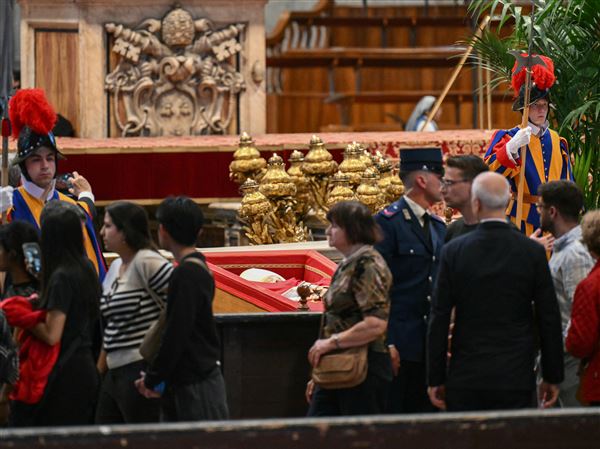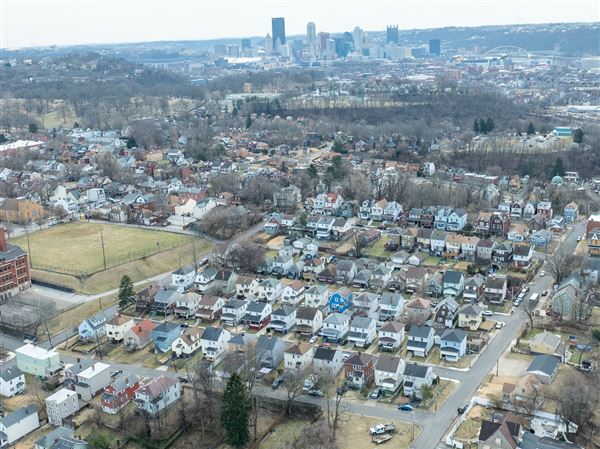Once, two churches anchored Oakland’s western gateway at Fifth and Craft avenues — St. Peter’s Episcopal Church and St. Agnes Roman Catholic Church.
St. Peter’s stood on Grant Street, Downtown, until 1901 when industrialist Henry Clay Frick paid to move it to Oakland. In 1990, St. Peter’s, Pittsburgh’s oldest church, was demolished after the Episcopal Diocese sold it to Oxford Development for $1.6 million. In 1999, Carlow University opened its A.J. Palumbo Hall of Science and Technology Hall on the former St. Peter’s site at 3200 Fifth Ave.
Now Carlow proposes to demolish St. Agnes Center, the name it uses for the church, and build a 10-story, 400,000-square-foot building for its health science programs. In addition, a rectory that houses faculty offices is slated for demolition and the development will use all of Parking Lot A, which faces Fifth Avenue and holds 120 cars when a valet is available during the day. Work cannot start until Carlow’s institutional master plan is approved by the Pittsburgh Planning Commission, the city zoning board and City Council.
Carlow plans to renovate St. Agnes School because it operates a program that serves pre-kindergarten through eighth grade students. University students earning education degrees do their student teaching in that program.
The Pittsburgh Catholic Diocese closed St. Agnes Church in 1993 and sold it and the rectory to Carlow in 1996. Carlow owns the three-story school, the church, the rectory, a 28-space parking lot at Fifth Avenue and Robinson Street plus a plot of sloped land that holds a statue of Jesus with his hands raised.
Carlow is also buying a vacant house at 134 Robinson St. and the empty land next to it with plans to turn it into a playground or a green space. The Robinson Street property is next to St. Agnes School.
Preliminary plans call for Carlow to use 100,000 square feet of the new building and the remaining 300,000 square feet to be leased for corporate offices. Carlow would give a 99-year lease for the land to The Elmhurst Group, using the lease payments to pay for the development. Carlow plans to sign an agreement this month with Elmhurst. Brian A. Miller, director of development for Elmhurst, did not respond to a request for comment.
David Meadows, Carlow’s chief financial officer, outlined the university’s plan last month at a meeting hosted by Oakland Planning and Development Corp.
John Comes — one of the best church architects of his generation — designed St. Agnes and insisted on using the finest materials.
In 1931, Felix Lieftuchter painted vivid murals on the church ceiling and walls with the help of two Carlow art students. In 2013, a blue and gold historical marker honoring Comes was unveiled outside the building.
Kathy Gallagher, a retired public school teacher who lives in North Oakland, said her grandfather, Patrick Francis Gallagher, was the general contractor on St. Agnes and other churches Comes designed.
“Carlow wants a gateway to its campus. What better way for a Catholic university to welcome its students than through a historic, former Catholic church?” Ms. Gallagher said.
“You can’t preserve those murals if you tear down the building,” she added.
Drew Wilson, a spokesman for Carlow, said no one was available to comment. Mr. Wilson said Carlow purchased St. Agnes School and the parking lot next to it from the diocese either in 2010 or 2011.
“The diocese made a decision to close it, and Carlow purchased it,” Mr. Wilson said.
Last year, Arthur Ziegler, president of Pittsburgh History & Landmarks Foundation, the city’s oldest preservation group, invited Stanton Eckstut of Perkins Eastman architects to meet with Carlow officials, tour the campus and St. Agnes.
Mr. Eckstut knows Pittsburgh well. In the 1990s, he drafted a plan to oppose wholesale demolition of historic Downtown buildings on Fifth and Forbes avenues. He was a preservation architect for Congregation Rodef Shalom and did the historic survey for The Pennsylvanian, a Downtown landmark that still stands and was designed by Daniel Burnham.
St. Agnes, Mr. Eckstut said, has “a beautiful facade and character that someone could take advantage of that they could never achieve with a new building. Make the church the entrance to the new building.”
Young people, he said, “don’t even like new buildings. They want historic stuff.”
Mr. Eckstut created the Audible Innovation Cathedral for Audible.com, turning a historic church into Audible’s company headquarters in Newark, N.J.
Mr. Eckstut noted that there’s plenty of land on Carlow’s, 15-acre campus.
“They owe it to themselves to give it a little more thought and time before they abandon it,” he said.
David McMunn, who often led tours of St. Agnes, said the church is acoustically perfect and that the Bach Choir and other music ensembles have performed there.
Mr. McMunn, who lives in Greensburg, said Carlow “has a mission to make a steel and glass corridor along Fifth Avenue just like University of Pittsburgh and UPMC did at the other end. Forbes and Fifth will be these steel and glass walls. There’s very little left of the old architecture.”
Ellen Mady, a spokeswoman for the Roman Catholic Diocese of Pittsburgh, said St. Agnes Church was not relegated to what diocesan officials call “profane but not sordid use,” meaning that the building is de-consecrated.
That process requires the property owner to ask the bishop to change the church’s designation. If the bishop approves, all sacred objects must be removed.
Marylynne Pitz: mpitz@post-gazette.com, 412-263-1648 or on Twitter:@mpitzpg
Correction, made at 2 p.m. March 17: An earlier version of this story incorrectly identified the chair of the school's board of trustees. The chair of the board of trustees is Dorothy Davis.
First Published: March 16, 2020, 9:45 a.m.















